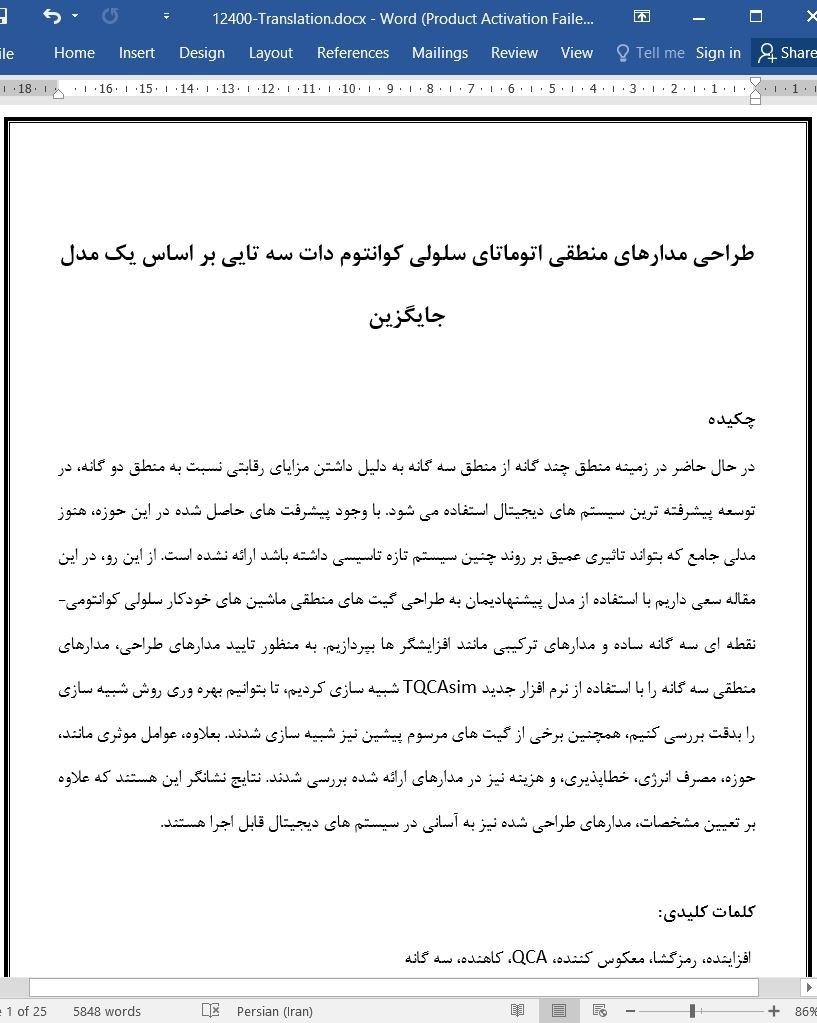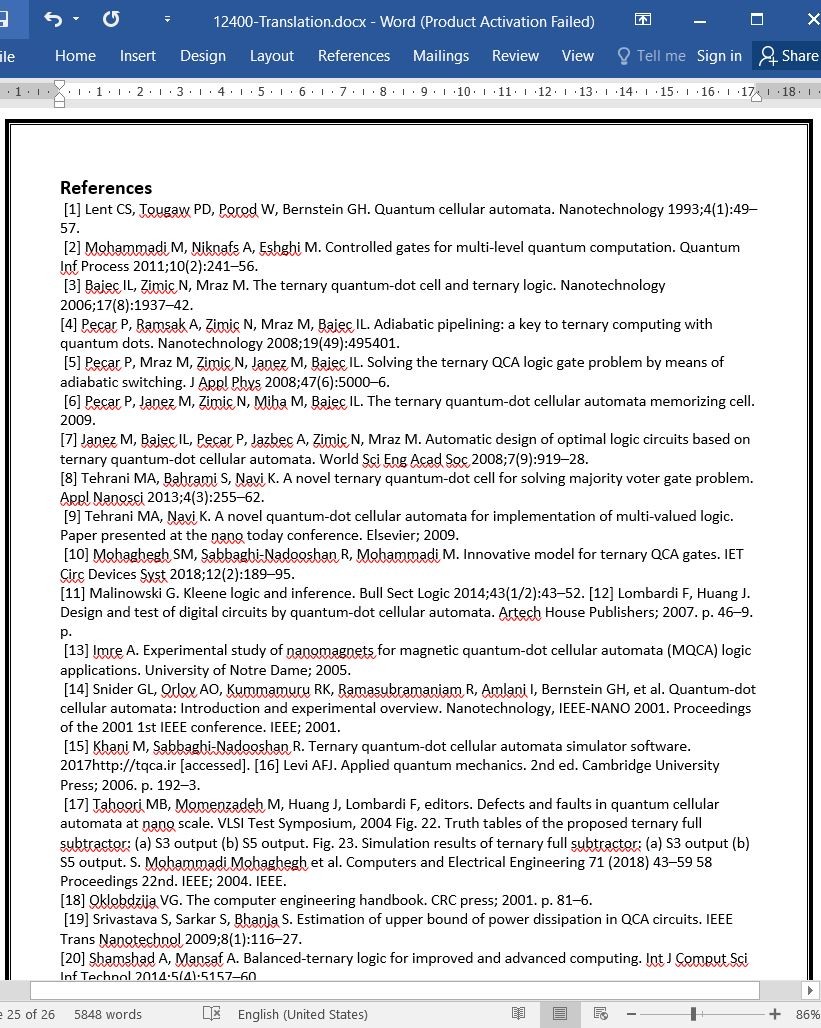
طراحی مدارهای منطقی اتوماتای سلولی کوانتوم دات سه تایی بر اساس یک مدل جایگزین
چکیده
در حال حاضر در زمینه منطق چند گانه از منطق سه گانه به دلیل داشتن مزایای رقابتی نسبت به منطق دو گانه، در توسعه پیشرفته ترین سیستم های دیجیتال استفاده می شود. با وجود پیشرفت های حاصل شده در این حوزه، هنوز مدلی جامع که بتواند تاثیری عمیق بر روند چنین سیستم تازه تاسیسی داشته باشد ارائه نشده است. از این رو، در این مقاله سعی داریم با استفاده از مدل پیشنهادیمان به طراحی گیت های منطقی ماشین های خودکار سلولی کوانتومی-نقطه ای سه گانه ساده و مدارهای ترکیبی مانند افزایشگر ها بپردازیم. به منظور تایید مدارهای طراحی، مدارهای منطقی سه گانه را با استفاده از نرم افزار جدید TQCAsim شبیه سازی کردیم، تا بتوانیم بهره وری روش شبیه سازی را بدقت بررسی کنیم، همچنین برخی از گیت های مرسوم پیشین نیز شبیه سازی شدند. بعلاوه، عوامل موثری مانند، حوزه، مصرف انرژی، خطاپذیری، و هزینه نیز در مدارهای ارائه شده بررسی شدند. نتایج نشانگر این هستند که علاوه بر تعیین مشخصات، مدارهای طراحی شده نیز به آسانی در سیستم های دیجیتال قابل اجرا هستند.
1. مقدمه
طبق قانون گوردون مور، هر 18 ماه تعداد ترانزیستورهای استفاده شده در تراشه ها دو برابر می شود که این امر باعث صرفه جویی در فضا و کوچکتر شدن اندازه وسیله می شود. با تولید گرما محدودیت های تکنولوژی سنجش CMOS، چگالی و سرعت دستگاه را تحت تاثیر قرار می دهد. چنین مسائلی باعث ترغیب تکنولوژی های جایگزین برای توسعه فناوریهایی مانند ماشین های خودکار سلولی کوانتومی-نقطه ای (QCA)، تونل زنی الکترون منفرد، الکترونیک مولکولی، نانوسیم ها، نانولوله ها، منطق فاز تونل زنی، دستگاه های بازآوایی تونل زنی، ترانزیستورهای چرخشی، و الکترونیک ابر رسانا، می شود.
در QCA برای اولین بار توسط (1) اظهار شده است که، اطلاعات را میتوان به جای استفاده از یک جریان الکترونیکی با ایجاد یک حالت قطبی از یک سلول به سلول دیگر انتقال داد. QCA با داشتن مزایایی همچون اندازه کوچک، تراکم فشرده سازی بالا، تاخیر پایین سیگنال، و مصرف انرژی پایین اخیرا توجه زیادی را معطوف خود کرده است. QCA ابتدا بصورت دوگانه ارائه شد، اگرچه بیش از 2 مقدار واقعی وجود دارد که به منطق چند گانه (MVL) معروف است، و باعث تسریع عملکرد و کاهش ورودی/خروجی می شود (2). از میان منطق های MVL، منطق سه گانه (tQCA) کاربردی ترینشان می باشد. جرئیات بیشتر در رابطه با tQCA و QCA در بخش های بعدی ارائه خواهد شد.
6. نتیجه گیری
ما مدلی جایگزین برای بکارگیری مدارهای منطق سه گانه ارائه دادیم و جهت کسب اطمینان از توانایی مدلمان در مدارهای دیجیتالی، از یک روش جدید شبیه سازی استفاده کردیم. این مدل که قبلا معرفی شده است بر اساس روابط میان الکترون ها و محاسبات انرژی آنها در سلولهای سه گانه بنا یافته است و می تواند مشکلات منطقی سه گانه ساختارهای QCA را برطرف سازد. با استفاده از مدل پیشنهادی، گیت های سه گانه ساده ای مانند، اقلیت، اکثریت و انواع مختلف معکوس کننده ها، و مدارهای ترکیبی سه گانه مانند رمزگشاها، چرخه، افزاینده، کاهنده، طراحی و شبیه سازی شدند. بر اساس آخرین مشاهدات، نتیجه گرفتیم که مقادیر درستی برای خروجی ها و شبیه سازی ساعت بدست آمده است. بعلاوه، موارد برجسته ای مانند حوزه، مصرف انرژی، هزینه، نقص، خطاپذیری در مدارهای پیشنهادی لحاظ شده اند. همچنین، هیچ مثال نقضی در میان نتایج دیده نشد. این بررسی ها نشان دهنده منطقی بودن مدل پیشنهادی هستند، بنابراین طراحی هر گونه مدار منطقی سه گانه با استفاده از مدل پیشنهادی امری ممکن است.
Abstract
Three-valued logic is recently being considered in the field of multi-valued logic due to its competitive advantages over binary logic for development of state-of-the-art digital systems. Despite several advances in this area, a comprehensive model that could have a profound impact on the trend of such a newfound system has so far not been proposed. Therefore, this study is an attempt to design basic ternary Quantum-dot Cellular Automata logic gates and various combinational ternary circuits like adders by use of our proposed model. To verify the design circuits, proposed ternary logic circuits are simulated by newly designed TQCAsim software while to scrutinize the effectiveness of simulation method, some prior proposed conventional gates have also been simulated. Moreover, effective factors such as area, energy consumption, fault tolerant and cost are investigated in the proposed circuits. The results show that, in addition to proper characterization, designed circuits are conveniently applicable for digital systems.
1. Introduction
According to Gordon Moore's law, every 18 months the number of transistors that could be integrated into a single chip is doubled which results in saving space and minimizing device sizes. The limitations of CMOS technology scaling caused by heat generation affect the device speed and density. This calls for alternative technologies to develop such as quantum-dot cellular automata (QCA), single electron tunneling, molecular electronics, silicon nanowire, carbon nanotube, tunneling phase logic, resonant tunneling devices, spin transistors and superconducting electronics.
In QCA which first proposed by [1], information can be transferred from one cell to another by propagating a polarization state instead of electrical current. Owing to beneficial properties like small size, high packing densities, small signal delays and low power consumption, QCA has gained attention recently. It was first proposed in binary form, though, there are more than two truth values known as multi-valued logic (MVL), that provides fast performance and inputs/outputs reduction [2]. Among the MVL logics, ternary logic (tQCA) is the most practical one. More details on QCA and tQCA will be presented in further sections.
6. Conclusion
We have demonstrated an alternative model for implementing ternary logic circuits and to ascertain our model capability in digital circuits, a novel simulation method is accomplished. This model which is presented earlier is based on the electron-electron interactions and their energy calculations in ternary cells and it can effectively solve the problems of ternary logic QCAs structures. Exploiting the proposed model, the basic ternary gates -such as Min, Max and various kind of inverters- and subsequently combinational ternary circuits -such as a decoder, cycle, adder, and subtractor- are designed and simulated. Based on the final observation, it is concluded that the correct value for the output and accurate clock simulation is achieved. In addition, prominent items such as area, energy consumption, cost function, defect, and fault tolerant are considered in the proposed circuits. Furthermore, no counterexample was found among the outcomes. These investigations reveal that the proposed model appears to be logical, hence, it is possible to design any ternary logic circuits by use of the proposed model.
چکیده
1. مقدمه
2. پس زمینه QCA دوگانه و سه گانه
3. طرح منطق سه گانه مطرح شده
4. گیت های سه گانه ساده پیشنهادی
4.1 سیم سه گانه
4.2 گیت های سه گانه اقلیت / اکثریت
4.3 معکوس کننده سه گانه
5. مدارهای سه گانه پیشنهادی
5.1 منطق رمز گشایی سه گانه
5.2 افزایش و کاهش سه گانه (چرخه)
5.3 نیم افزاینده سه گانه
5.4 تمام افزاینده سه گانه
5.5 نیم کاهنده های سه گانه
5.6 تمام کاهنده سه گانه
6. نتیجه گیری
منابع
ABSTRACT
1. Introduction
2. Background of binary and ternary QCA
3. Proposed ternary logic design
4. Proposed basic ternary gates
4.1. Ternary wire
4.2. Ternary Min/Max gates
4.3. Ternary inverter
5. Proposed ternary circuits
5.1. Ternary decoder logic
5.2. Ternary increment and decrement (Cycle)
5.3. Ternary half adder
5.4. Ternary full adder
5.5. Ternary half subtractor
5.6. Ternary full subtractor
6. Conclusion
References
- اصل مقاله انگلیسی با فرمت ورد (word) با قابلیت ویرایش
- ترجمه فارسی مقاله با فرمت ورد (word) با قابلیت ویرایش، بدون آرم سایت ای ترجمه
- ترجمه فارسی مقاله با فرمت pdf، بدون آرم سایت ای ترجمه



